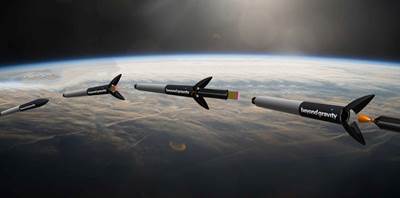Toyota invests in Interstellar, enters reuseable launch rocket market
A deepened strategic alliance with the Japanese startup will combine Toyota’s automotive expertise and Interstellar’s CFRP know-how for mass rocket production.
Interstellar Technologies’ Zero fairing separation testing in February 2023. Source (All Images) | Interstellar Technologies Inc.
Automotive manufacturer Toyota Group (Toyota City, Japan) is entering the high-rate reusable launch rocket market with its recent $44.3 million investment in (Hokkaido, Japan). The announcement was made by CEO . The rocket developer startup, “seeking to emulate SpaceX’s vertical integration strategy by launching vehicles and communications satellites in-house,” according to an , will be leveraging Toyota’s automotive production method expertise for its mass manufacturing goals.
Small satellite launches surged in 2023 — Interstellar reports 116 launches conducted in the U.S., 63 in China and three in Japan. The company, aligned with the Japanese government’s target to secure a domestic launch capacity of around 30 launches annually by the early 2030s, says it has been collaborating with Toyota Motor Corp. since 2020 to accelerate its rocket and satellite communications business. This most recent strategic capital gain through Woven by Toyota Inc., a Toyota Group company (more in the sidebar below), further strengthens this business alliance which focuses on cost reduction, shortening lead times and creating a mass production system for rockets. Woven will also take a director seat on Interstellar’s board.

Interstellar’s rocket lineup.
“Toyota continues its transformation into a mobility company by embracing challenges in land, sea and air mobility,” says Hajime Kumabe, CEO of Woven by Toyota. “Interstellar Technologies is a company that is in close alignment with our own vision for the future of movement. This business alliance will leverage the Toyota Group’s extensive manufacturing capabilities and combine our expertise to advance rocket production and further drive mobility transformation.”
Interstellar Technologies has some history of using carbon fiber-reinforced polymer (CFRP) components and structures. This is most apparent through the development of its two-stage Zero suborbital-class rocket, which it plans to launch to space in 2025. A follow-up to the company’s sound rocket Momo, Zero features a 3.6-meter-high and 1.7-meter-diameter fairing made of CFRP. , Interstellar conducted a fairing separation test at its Fukushima Robot Test Field, which separated as designed and detached properly from the vehicle body, leading to plans to begin design and manufacture of the flight model.
Of additional note is Zero’s fuselage structure, which “adopts a sandwich structure with an aluminum core material sandwiched between CFRP,” .
Zero is capable of carrying an 800-kilogram payload to low-Earth orbit. Aviation Week notes that Interstellar is also working on a reusable heavy lift rocket, Deca, that would start operations in the 2030s. Interstellar says this rocket will maintain the design concepts and production technologies demonstrated and accumulated through Interstellar’s Momo and Zero rockets — therefore, continued use of composites is likely.
Toyota Group has its own background in the support and use of composite materials for its own mobility solutions, or applications it has financially invested in. Most recent is the additional $500 million Toyota Motor Corp. invested into electric vertical takeoff and landing (eVTOL) manufacturer Joby Aviation (Santa Cruz, Calif., U.S.) to support the composites-intensive aircraft’s certification and commercial production. As described in CW’s Joby Aviation plant tour, Toyota has also helped Joby to focus on industrial production, including CFRP airframes, in which “Toyota engineers are highly visible and heavily embedded in the [Joby’s] Marina facility, bringing their own manufacturing rigor and expertise to the eVTOL production process.”
Regarding Toyota’s automotive focus:
- The Toyota Hyper-F concept aims to incorporate carbon fiber-reinforced PP and 3D printed components for decorative parts.
- Toyota and BMW made an announcement in September 2024 that the automotive giants are preparing for series production of a fuel cell electric vehicle (FCEV) passenger vehicle option for 2028 using composite pressure vessels for hydrogen storage.
- Toyota Motors North America is going to be supplied with Hexagon Purus’ (Oslo, Norway) hydrogen storage and high-voltage battery system to support Class 8 heavy-duty fuel cell powertrains.
In the CES press conference, CEO Toyoda described in the world of mobility: “We believe that by combining Toyota's strengths with those from different industries, we’ll be able to create new value, new products and new services we could never achieve on our own. ... we're exploring rockets too — because the future of mobility shouldn’t be limited to just Earth, or just one car company for that matter!”
Related Content
Syensqo becomes new Solvay specialty materials company
Syensqo represents what was Solvay Composite Materials, focused on delivering disruptive material technologies and supporting growing customer needs.
Read MoreSinonus launches energy-storing carbon fiber
Swedish deep-tech startup Sinonus is launching an energy-storing composite material to produce efficient structural batteries, IoT devices, drones, computers, larger vehicles and airplanes.
Read MoreCIRA qualifies CMC structures for the reusable Space Rider
Italian team designs, builds and tests multiple large, complex thermal protection system structures made from patented ISiComp C/C-SiC ceramic matrix composites.
Read MoreTPI manufactures all-composite Kenworth SuperTruck 2 cab
Class 8 diesel truck, now with a 20% lighter cab, achieves 136% freight efficiency improvement.
Read MoreRead Next
On the radar: Reusable launch vehicles, hypersonics make space more accessible
CFRP has become key to targeting efforts in reusing components like rocket stages, as well as the development of reusable hypersonic testbeds and spaceplanes, for increasing space commercialization.
Read MoreBeyond Gravity innovates space with reusable payload fairing
Reuse of composite second stage half-shells could make rockets more accessible to various companies and support more frequent launches.
Read MoreDawn Aerospace reusable rocket-powered aircraft flies twice in one day
Eighth and ninth flights of composites-intensive Mk-II Aurora reach an altitude of 63,000 feet, demonstrates same-day reusability capability for rocket-powered systems.
Read More












